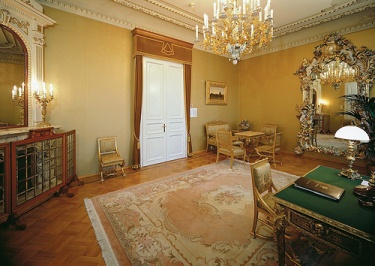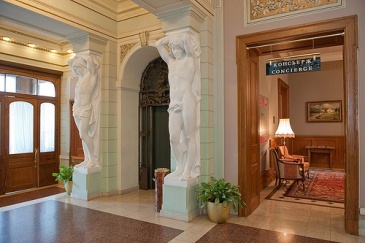

Mokhovaya Ulitsa 15/1
Tel. (495) 258 7000
Subway:
Okhotnyy Ryad
The National Hotel is a Moscow hotel located on Mokhovaya Street, 15/1. It was built in 1900-1902 according to the project of the architect Alexander Ivanov. At the time of opening, it was considered one of the most prestigious in Moscow. After the Revolution of 1917, for several years the building housed a hostel for officials of the Soviet government. In 1932 the hotel was revived under its former name.
In 1900, the site at the beginning of Tverskaya
Street, where the old Balaklava tavern was located, was acquired by the
Varvara joint-stock company of homeowners. The company decided to build
a new luxurious hotel on this site, the project of which was ordered
from the St. Petersburg architect Alexander Ivanov. The building was
designed in the Art Nouveau style with neo-Renaissance and neo-classical
decorative elements. The facade was finished with natural stones,
ceramic tiles and stucco. The corner attic was decorated with a majolica
panel "Apollo and the Muses", created by artists Sergei Chekhonin and
Alexander Golovin at the Abramtsevo ceramic factory of businessman Savva
Mamontov.
The building was erected using advanced materials:
reinforced concrete, facing bricks, waterproofing materials. During the
restoration of the hotel in 1994-1995, an analysis of the solution was
carried out, with which the crowning cornice was fixed. The results
showed that the builders carried out special technological measures that
ensured high moisture resistance of the mortar and, as a result, its
almost perfect preservation 90 years after construction.
The
architect Ivanov used several technological innovations when creating
interiors. In particular, on the main staircase, he made openwork marble
steps without stringers, which creates the feeling that they are
floating in the air. In fact, the steps are fixed on metal structures
hidden in the wall.
On December 29, 1902, the grand opening of the hotel
took place, and on January 1, 1903, the first guests settled. The
premises in the six-storey building were partially rented out. The first
two housed restaurants, Chuev's confectionery, fur shops of the Petukhov
brothers and the tea merchant Perlov.
The hotel was equipped with
the latest technology. Elevators were installed in it, which was
considered a great curiosity, as well as furniture and chandeliers
exclusively imported. All 160 rooms were equipped with water closets and
telephones. Accordingly, the prices for accommodation were quite high -
up to 25 rubles per day.
The hotel has become a favorite place of
residence for Petersburgers and foreigners. Writer Dmitry Merezhkovsky
and poetess Zinaida Gippius, ballerina Anna Pavlova and composer Nikolai
Rimsky-Korsakov stayed here. In 1913, the writer Anatole France lived in
the hotel, and a year later, the science fiction writer HG Wells.
Several memorable episodes are associated with the National Hotel. In
this building, on October 3, 1910, the first chairman of the State Duma,
Sergei Muromtsev, died of heart failure. In the spring of 1906, while
the Socialist-Revolutionaries were preparing an assassination attempt on
the Moscow Governor-General Fyodor Dubasov, the terrorist Boris
Vnorovsky lived in a hotel with a false passport. He chose a room with
windows on Tverskaya Street in order to keep an eye on the official
leaving the residence.
1st House of Soviets
In early 1918, after the
transfer of the capital of the RSFSR to Moscow, the National Hotel was
nationalized and renamed the 1st House of Soviets. Soviet officials of
the people's commissariats temporarily settled in the former rooms.
Before moving to the Kremlin, the chairman of the Council of People's
Commissars Vladimir Lenin and Nadezhda Krupskaya lived in suite No. 107
on the third floor.
In the summer of 1924, the Fifth Congress of
the Comintern took place in Moscow. The invited foreign socialists
settled in the former National. On August 2, they greeted the
demonstrators from the balcony, who passed by with banners "Saving the
world from new wars in the dictatorship of the proletariat."
From
December 1920 to April 1921, the head of the Republic of Dagestan, Jelal
Korkmasov, lived in room number 326. In this issue, Korkmasov met with
the ambassador of the government of Mustafa Ataturk in Moscow, Ali Fuad,
and representatives of the Turkish delegation before the official
opening of the Moscow Conference on the Turkish Question.
From July 1, 1931 to December 31, 1932, a large-scale
reconstruction and restoration of the interiors of the hotel was carried
out in the building. For the renovated premises, furniture was used from
the former residences of aristocrats, and, in particular, from the
Anichkov and Tsarskoye Selo palaces. After the restoration of the hotel,
restaurants named after the cities of the Golden Ring appeared on the
second floor. From "Moskovsky" the best view of the Kremlin opened. The
windows of the Suzdal restaurant overlooked Tverskaya and Okhotny Ryad.
The room, where the Kostroma restaurant was later located, was occupied
by a children's room in the 1930s, where you could leave children under
the supervision of teachers.
During the reconstruction, the
original majolica panel on the facade was replaced with a new one, made
by Ivan Rerberg. The theme of the image - the work of a Soviet worker -
was made within the framework of the "Monumental Agitation and
Propaganda" plan developed by Lenin.
"National" was intended,
first of all, for visiting foreigners. Accordingly, there were strict
rules in the hotel. According to the memoirs of Yudifi Yazvina, once in
the 1930s, together with the poets Mikhail Svetlov and Mikhail Golodny,
a doorman dressed in a livery with galloons did not let her into the
hotel. Probably the reason for the refusal was the fact that Hungry was
wearing a simple kosovorotka.


In 1936, the Austrian Social Democrat Professor of Medicine Julius
Tandler moved to Moscow. He signed a contract with the People's
Commissariat of Health and began to advise Soviet specialists on the
construction of medical facilities. The Moscow authorities gave him
a room at the National with a view of the Kremlin. During the Great
Patriotic War, foreign leaders of the anti-fascist movement and
representatives of the Red Cross lived in the hotel.
During
his visits from Leningrad, the composer Nikita Bogoslovsky stayed in
the hotel suite. After moving to the capital, he often dined at the
National restaurant. The poet Mikhail Svetlov, who lived in
Kamergersky Lane, often appeared there. In the restaurant, one could
also meet the writer Yuri Olesha. There is a legend that Andrei, the
son of the Soviet artist Boris Ioganson, while sitting in a
restaurant, drew a sketch of the label for Stolichnaya vodka: the
image on the label really matches the view that opens from the
windows of the National to the Moskva Hotel.
When developing
a plan for the reconstruction of Gorky Street (Tverskaya after
renaming), it was decided that on the left side the buildings of the
National and the Central Telegraph would remain unchanged. The rest
of the houses located up to Sovetskaya Square were subject to
demolition.
In the early days of outbound tourism in the
Soviet Union, the hotel housed an institution where citizens could
officially exchange rubles for foreign currency. In 1974, the
building of the National was included in the list of historical and
cultural monuments protected by the state. In the same year, the
ceilings of the halls on the second floor were painted by the artist
Ivan Nikolaev. Although the hotel was intended for the accommodation
of honored foreign guests, in the late Soviet era, both the building
itself and its interior were in an unsatisfactory condition.
In the 1980s, a decision was made to restore the National. In 1991,
the Austrian company Rogner was chosen as the general contractor,
and the Mosproekt-2 department also took part in the work. The
restoration project was developed by Austrian architects W.
Hoffelner and E. Survillo. The work was completed in 1995. Several
historical suites have been restored in the hotel, where antique
furniture and decor items from the early 20th century have been
preserved. The Presidential Suite has a Rud grand piano. Ibach Sohn
made in Germany in the 19th century. It is noteworthy that the
original stained-glass windows of 1902 have been preserved in the
building on the main staircase.
In 2003, a terrorist attack
occurred near the hotel building, during which six people were
killed and 14 were injured. In the fall of 2010, the hotel was
transformed from a unitary enterprise into an open joint stock
company. On December 22, 2011, an auction was held in Moscow, where
the shares of the hotel were put up for sale. The full package was
purchased for 4.67 billion rubles by businessman Sait-Salam
Gutseriev, the brother of the owner of Russneft.
As of 2020,
National is the only Russian hotel of The Luxury Collection brand.
In Andrey Bely's novel Moscow Under Attack, the Japanese
mathematician Issi-Nissi is staying in a hotel.
The plot of
Viktor Pelevin's novel "The Sacred Book of the Werewolf" begins with
the tragic events in the "National".